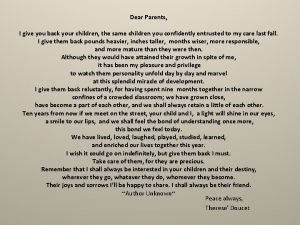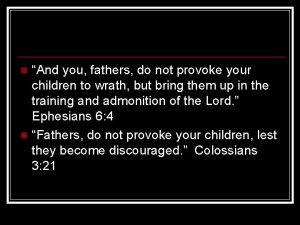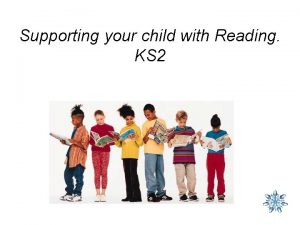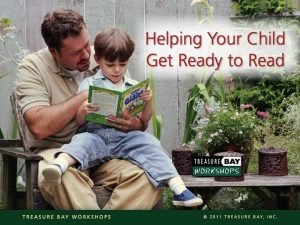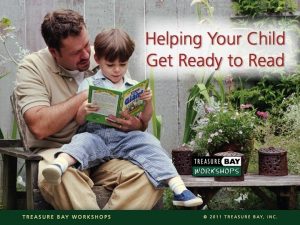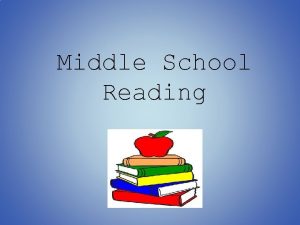Overview Reading to your child or with your




















- Slides: 20


Overview • Reading to your child or with your child? • When. . . What. . . Why read together? • Tips on how to get started • Three styles of reading together • Tips for during and after reading together • Books designed for reading together

Transitions in Reading to your child is one of the most important things you can do to help your child become a good reader. . . but perhaps it’s time to start reading with your child.

What Is Reading Together? Three elements: 1. You read aloud to your child. 2. Your child reads aloud to you. 3. You talk about what you are reading.

When to Start You can start when your child: • Knows letter sounds • Is starting to sound out words or guess words from picture clues

Why Read Together? 1. 2. 3. 4. Transition to independent reading Enjoyable experience, fostering a love of reading Opportunity for practice and supportive feedback Gives child a break and keeps the reading flowing and fun 5. Accelerates development of vocabulary, comprehension, and fluency Bottom line: It will help your child to read sooner and better—and help develop a love of reading.

Choosing What to Read Together 1. Choose any book with text at your child’s reading level. 2. Choose books that your child is interested in. 3. Let your child pick the book or offer a selection. 4. Reread books read before. 5. Consider “read together” books.

Before Reading Together 1. 2. 3. 4. 5. 6. Sit together in a comfortable, well-lit place. Hold the book so your child can easily see the words. Talk about the topic, what the book might be about. Page through the book together and discuss it. Consider reading the entire book to your child first. Decide on a read-together format: • Choral reading • Echo reading • Shared reading 8

Choral Reading 1. Ask your child to read aloud along with you (reading the same text at the same time). 2. Start louder and slightly faster than your child. 3. When your child gains confidence, become slower and quieter. 4. Read with expression and show attention to the phrasing and punctuation. 5. Maintain a comfortable pace by speeding up or slowing down when needed.

Echo Reading 1. Take turns reading the same text. 2. Read a sentence, making your reading as fluent and expressive as possible. 3. Then ask your child to read the same sentence. 4. Run your finger under the text as each of you reads. 5. Continue until your child starts to read with expression and fluency. 10

Shared or Paired Reading 1. Take turns reading aloud. 2. Agree on signals for switching. 3. Start by reading some text, and then signal for your child to take over and read. 4. Watch for sentences, phrases, or words that are easy enough for your child to read. 5. Nudge your child to read the next word, sentence, or page. 6. Invite your child to read one character’s dialogue. 7. Allow your child to signal your turn to read again.

While You Are Reading 1. Read with expression— make the story come alive. 2. Try using different voices for different characters. 3. Point out rhyming words. 4. Stop and discuss new vocabulary words. 5. Talk about how you understand new words. 12

While You Are Reading (cont’d) 6. Talk about what is happening in the story and ask what might happen next. 7. Ask open-ended questions about the story. 8. Decide when to invite your child to begin reading. 13

While Your Child Is Reading 1. Encourage your child to mimic the way you read to gain fluency. 2. Help your child use context and pictures to figure out unknown words. 3. If your child might be able to sound out a word or starts to sound one out, provide encouragement. 4. If your child struggles with a word for 5 seconds, provide the word.

While Your Child Is Reading (cont’d) 5. Suggest rereading a difficult sentence. 6. See if it is helpful for your child to run her finger under the words as she reads. 7. Encourage your child to ask you about anything he doesn’t understand. 15

While Your Child Is Reading (cont’d) 8. If your child does not understand what she is reading, stop and discuss it, and ask her to read it again. 9. Praise your child’s efforts. Praise often. 10. Keep the reading fun. Some struggle is good. Too much frustration is not good. 11. Know when to take over reading or end the session.

After Reading 1. Have a short discussion about the story. 2. Help your child to summarize the main idea. 3. Discuss the problem and solution of the story. 4. Ask open-ended questions about the story or subject of the book. 17

After Reading (cont’d) 5. Help your child make connections to her world or another story or book. 6. On subsequent readings, consider having your child read the entire book to you. 7. Be willing to read the same book several times. 18

Series Designed for Shared Reading You Read to Me, I’ll Read to You By Mary Ann Hoberman We Both Read Published by Treasure Bay “A friend!” Ma x exclaimed, del ighted by the sight. The cat yawned a huge, lazy yaw thought it made n and Max her look just like a lion! “We can play circ us, ” he said wit “I can be the ring h a smile. master. ” the lion. “You can be icks. ” We will do tr 19

Wrap-Up and Q & A 20
 Pre reading while reading and post reading activities
Pre reading while reading and post reading activities Left child right sibling tree
Left child right sibling tree John agard windrush child
John agard windrush child St. louis
St. louis Aims and objectives of teaching
Aims and objectives of teaching Type of reading
Type of reading What is shared reading
What is shared reading Prerequisite of discovery in critical reading
Prerequisite of discovery in critical reading Real definition of extensive reading
Real definition of extensive reading Extensive reading
Extensive reading Developing effective reading skills
Developing effective reading skills Give us your hungry your tired your poor
Give us your hungry your tired your poor Parents do not provoke
Parents do not provoke I give you back your child poem
I give you back your child poem Parents do not provoke your child to wrath
Parents do not provoke your child to wrath Your child's success or lack of success
Your child's success or lack of success Asvab cep post-test interpretation
Asvab cep post-test interpretation Your child's success or lack of success
Your child's success or lack of success What s your favorite subject
What s your favorite subject Through your child's eyes: american sign language
Through your child's eyes: american sign language Woe unto you when your king is a child
Woe unto you when your king is a child













